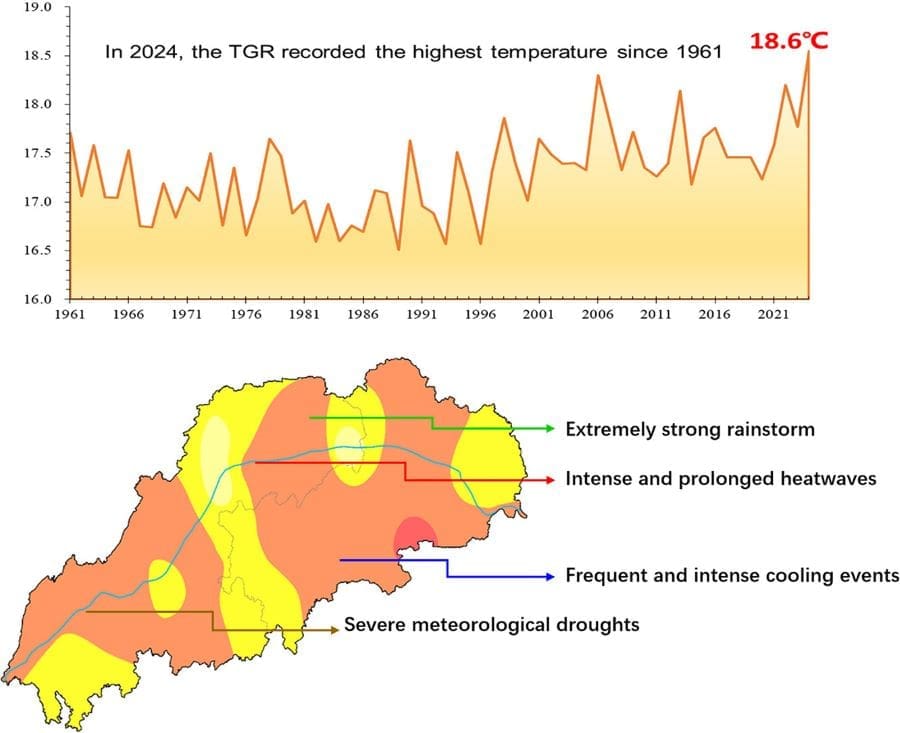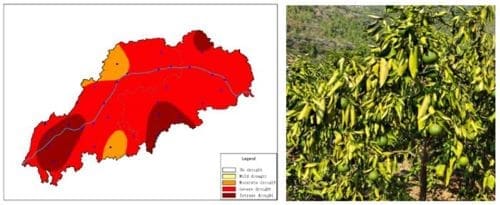Summary:
China’s Three Gorges region experienced record-breaking heat and a series of extreme weather events in 2024, according to a new study published in Atmospheric and Oceanic Science Letters by researchers from the National Climate Center. The report, led by Professor Xianyan Chen, found that the area’s annual mean temperature reached 18.6 °C – 1.2 °C above the long-term average and the highest since records began in 1961. Spring and autumn were particularly warm, each setting new seasonal records, while the total number of high-temperature days climbed to 57.2 – also a record since 1961 and surpassing the previous high set in 2022.
Rainfall was 11.2% below normal for the year, with drier-than-average conditions in spring, summer, and autumn. Despite the overall decline, the number of heavy-rain days slightly exceeded normal, with some regions experiencing severe convective storms and early-onset rain events. The year was also marked by frequent cold spells, intense rainstorms, low humidity, and reduced fog coverage.
The Three Gorges region spans Chongqing Municipality and Hubei Province, forming a vital link between western and central China. Its climate affects agriculture, energy, and navigation on the Yangtze River, making continuous monitoring critical for disaster prevention and regional planning.

The Three Gorges region of the Yangtze River hits record high temperatures in 2024
The Three Gorges Region (TGR) of the Yangtze River spans Chongqing Municipality and Hubei Province, serving as a vital corridor connecting western and central China. The climate in the TGR features four distinct seasons with abundant precipitation and synchronized rain–heat periods.
The climatic conditions in the TGR directly impact the safety of navigation in the Yangtze River, as well as the basin’s agricultural production patterns and clean energy supply, all of which are crucial to regional socioeconomic development and ecological conservation. Therefore, continuous monitoring of climate and extreme weather events in the TGR holds significant importance.

Recently, a research team led by Prof. Xianyan Chen from the National Climate Center published a detailed report in Atmospheric and Oceanic Science Letters (AOSL), outlining the major climate and anomalies in the TGR during 2024, along with significant weather and climate events.
The report provides essential observational data and analysis for climate assessment and research in the TGR.
The research team pointed out that in 2024, the annual mean temperature in the TGR set a new historic record, exceeding the norm by 1.2°C. Both spring and autumn recorded their highest temperatures since 1961.
Meanwhile, the number of high-temperature days also reached a historical peak, accompanied by the occurrence of extreme high-temperature events characterized by exceptionally intense and prolonged duration. These concurrent record-breaking phenomena collectively demonstrate a clear acceleration of climate warming trends.
Additionally, the results also showed that the annual rainfall in the TGR was 11.2% below normal, yet the number of heavy-rain days were slightly higher than normal. Notably, heavy rainfall (including severe convective weather) events occurred earlier than normal, with more frequent extreme precipitation events.
This marks the sixth consecutive year that the National Climate Center has released its annual climate report for the TGR in AOSL. The report provides an important scientific basis for understanding regional climate change patterns and mitigating meteorological disasters. Furthermore, it provides essential data support for the operation, dispatch, and regional disaster prevention efforts related to the Three Gorges Project.
Journal Reference:
Hongling Zeng, Xianyan Chen, Yundi Jiang, Xukai Zou, Tong Cui, Qiang Zhang, Linhai Sun, ‘State of the climate over the Three Gorges Region of the Yangtze River basin in 2024’, Atmospheric and Oceanic Science Letters 100664 (2025). DOI: 10.1016/j.aosl.2025.100664
Article Source:
Press Release/Material by Institute of Atmospheric Physics (IAP) | Chinese Academy of Sciences (CAS)
Featured image credit: Friedrich Frühling | Pixabay




